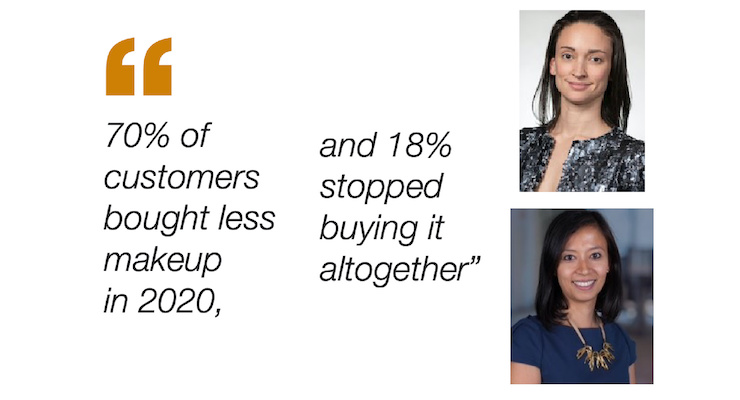Patricia Hong and Manola Soler, Alvarez & Marsal’s Consumer and Retail Group 04.28.21
When the Covid-19 pandemic hit in 2020, consumers’ routines were instantly disrupted. From remote working and learning, to extended closures of non-essential retailers, social distancing, and face masks becoming ubiquitous – 2020 was a year unlike any other.
A year after the first lockdown measures were implemented in the U.S., the A&M Consumer and Retail Group set out to understand how customer beauty preferences and behaviors have changed, and which of these changes may be here to stay.
In the A&M Consumer and Retail Group Beauty Survey most respondents indicated that, since Covid-19, they have either completely stopped or purchased fewer beauty products. Only 20% of respondents said their beauty routines remained unchanged.
How can beauty brands and retailers think about operating in this new reality and what factors will be critical in driving growth? We have outlined some key focus areas to consider as we navigate the next normal.
Ingredients Enter the Battle for Brand Loyalty
If the brand loyalty battle wasn’t already tough enough, it is about to get harder
Beauty brand loyalty was under pressure before Covid-19. Before the pandemic 33% of respondents did not have a go-to makeup brand and 25% did not have a go-to skin care brand.The trend is stronger in younger consumers, 47% of the 18-29 age range did not have a go-to brand in makeup or skin care.
Last year, lockdowns and social distancing made Instagram and Facebook the preferred channels to discover beauty. Influencers vying for attention armed customers with ingredient knowledge. The influx of consumers discovering beauty on social media ramped up comparison shopping and accelerated the shift towards ingredients-first product discovery.
In 2020, the desire for better ingredients was the top reason respondents switched skin care brands. During that time searches for “Hyaluronic Acid Skincare” and “Vitamin C Skincare” increased 5 times and 3 times respectively.
Brands and retailers will need to re-think product benefits and ingredients communication in order to attract consumers who feel empowered to be in the drivers’ seat of their beauty routines.
The Long-Term Impact of the Digital Explosion
Discovery and brand experience now need to also be digital
Beauty saw a massive shift to online shopping in 2020. Our respondents indicated that pre-Covid-19, about 34% of their beauty purchases were made online, this increased to about 47% during the pandemic.Much of the online shopping trends will stick post-pandemic and we predict a battle for share of online purchasing could ensue.
The results will come down to retailers’ and brands’ ability to leverage technology and content to maximize the digital customer experience. This will require both technology upgrades and operating model changes.
But digital alone will not be enough. While more people will shop for beauty online, only 6 to 9% expect to shop beauty exclusively online after Covid-19. This means that more customers than ever before will be exposed to brands across multiple online and in-person channels.
A cohesive and differentiated omni-channel brand experience will be paramount in this environment.
Re-Imagining the Store Experience
Accessible testers once revolutionized the in-store experience—what will replace them in a post-pandemic world?
The explosive growth of beauty specialty retailers was due in part to their innovative store experience. They eliminated beauty counters making testers accessible, and sales associates offered hands-on interactions. What happens now to this high-touch model?When asked how they feel about shared beauty testers only 15% of respondents said they feel comfortable using them today and 42% do not think they will ever use one again.
The outlook is similar for services like makeup application. Almost 20% feel comfortable with having their makeup done in-store today and 30% do not think they will use this kind of service again.
The product testing experience will need to evolve in-store and online. The future of in-store testers is uncertain in world hyper-focused on safety and hygiene, and some categories do not lend themselves to virtual try-on. Single-use samples, gift-with-purchase programs, for-sale minis, and subscription boxes are likely candidates to tackle the sampling problem. In makeup application enhanced hygiene protocols will pose logistical, operational, and cost hurdles that must be overcome.
Less is More—And the Role of Newness
What is the role of newness in the next normal?
In 2020 beauty slowed its frenetic launch cadence, we saw major launches rescheduled or re-imagined for a new consumer reality. But more importantly, consumers were not focused on newness.Only about 10% of respondents actively look for newness in beauty today. That trend is expected to grow in makeup, with 40% of respondents expecting to care even less about newness post-Covid-19. In skin care, however, 20% of respondents expect to care more about newness than they did pre-Covid-19.
The newness churn may have slowed this year as consumers focused on ingredients and product availability. However, the jury is still out on whether newness will be a critical factor in getting people to buy again in the near future.
For brands and retailers this means becoming more consumer-centric than ever before and creating agile supply chains that enable demand-led decisions to manage inventory risk in a volatile environment.
In Summary
While it is hard to truly grasp what the “new normal” will look like for beauty, brands must embrace that things will continue to change across the entire consumer journey.How they reach customers, how and where customers discover products, and how benefits are communicated will not return to what it was before. Evolving to meet the changing customer is table-stakes in this new world.
Creating a seamless and meaningful brand experience across channels will be critical. Companies that understand this and can re-imagine their operations will succeed.
New store formats that embrace safe interactions, life-like virtual try-ons and consultations, leading with ingredients and creating demand-based planning, that moves away from a traditional launch calendar, are just a few of the considerations brands and retailers have to rethink to win in beauty in the next normal.




























